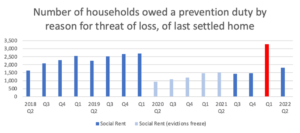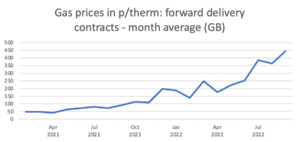
Housing is one of those topics that we hear about a lot, from all sides. In Havering, pretty much every political party is saying the same thing: “We don’t want high-rises.” Despite this, we are seeing the opposite in Romford; we are being let down when it comes to housing.
Romford is located in East London, on the border of Essex. It is undergoing a transformation from historic market town, to thriving London suburb, as Londoners move out from central boroughs in search of cheaper housing. The London borough of Havering, where Romford is located, has seen its population increase by over 10% in the last ten years, with its 25-34 year old age group rising by 24.5.%
At present, over 300 families are stuck in hotels and short-term lets across the borough. Things are so bad that homelessness is now a major part of our budget. It costs us millions. At the same time, we are going bankrupt.
Having a secure home is a life changer. It does not just mean you have somewhere to sleep – it means you have security. You can rest, focus on a job, build vital support networks, get to know your GP and keep your kids in the same school.
Given that Havering Council is currently forecasting a spend of £6m on hotels , and is facing £30m of additional pressure on social care, I am stunned at the housing approach that Labour and the Resident’s Association are taking. Our council seems more keen to build expensive private homes than the council homes we really need: social housing.
Every time I walk into Romford, I walk past the last empty site that is the former Waterloo Estate. This used to be home to hundreds of residents, but now it is a pile of gravel. Work was paused on the site in May 2023, after the Government announced new rules regarding building safety. The Government has since clarified that developments such as the Waterloo Estate can go ahead. But, in Havering, it has not.
One of our biggest social housing schemes sits getting stale. Initial plans included transforming the estate from just over 270 homes to 1380. Located a 5 minute walk from the Elizabeth line and just 30 minutes from Central London, it promised to be a thriving community of both social housing and attractive homes for your professionals. The site was due to deliver 40% of all of Havering Council’s housing pipeline. When demolition began in 2021, as many as 550 affordable homes were promised.
These now look to be many more years away, with both Havering Council, and joint venture partner Wates, still debating whether to restart works. Havering Council is currently exploring placing 20 ‘container homes’ on the site to offer temporary accommodation.
In the meantime, Labour and the RAs are looking to cram a new 12 storey tower block on the Como Street car park, completely out of character with the family homes nearby. The consultation process has been widely criticised by residents, an environmental impact assessment has been deemed as not needed and the council decided that it will only sell the site to a property company it owns. A property company that is prohibited from building social housing.
This is not the only example of bad management. Over at the Seedbed Centre, which has just received planning permission for another 840 homes, we are only going to get 10% of them as social homes. This is despite London-wide rules requiring 35% as a minimum. At a recent planning meeting, Councillors were told that this figure can be increased at a review later in the process. If we do not get those homes, the developer will make a financial contribution.
The developer? That’s Havering Council.
Havering needs a proper housing strategy and, despite complaints about the previous administration, we still have not had the local authority deliver the much anticipated Romford Masterplan – an administration that has been in power for nearly two years.
A proper local plan for Romford should be urgently produced. It should ensure that areas like Lower-Mawneys are not allocated a new tower block. Instead, it should demand a proper level of social housing, not payouts that only benefit us in the short term.
Havering has a rapidly growing population. It has grown by over 10% since 2011, and it looks like Romford is bearing the brunt of that. Rightly, we are getting thousands of new homes, but very few of those are council homes – the homes we need to tackle homelessness in Romford.
Whilst accepting low levels of social homes – and not getting on with those that already have planning permission, such as the Waterloo Estate – our council are investing in creating a new hostel at Royal Jubilee Court. A new hostel is a solution that can only ever be temporary. What message does this send to those on the social home waiting list?
Social housing makes financial sense. It means that rent is paid to the council, not just to private landlords. This means increased income and a reduced homelessness bill for Havering. Cheaper council housing also means that Havering’s many young families can stay together, rather than children having to move outside the borough to buy a home. It means stronger communities that grow and thrive together.
As I write, Havering Conservatives are putting together our alternative budget proposals. We have been informed that, for every resident relocated from temporary accommodation to permanent housing, Havering Council would save a minimum of £30k a year. A proper strategy, to house those currently homeless, would save the council at least £6m a year, at a time when it has a deficit of £32m and applying to the government for an emergency loan – a loan that will likely come with crippling interest repayments and increase the deficit further.
Havering Council is a bad example, and a warning. Before it closes and sells off our car parks or builds on the greenbelt – which is on the outermost edge of Greater London, and so far from people’s workplaces – it should finish what developments it has already started and deliver the social homes Havering needs.
David Taylor is the Conservative Councillor for Romford.
Views expressed in this article are those of the author, and not those of Bright Blue. [Image: Just Jus]












